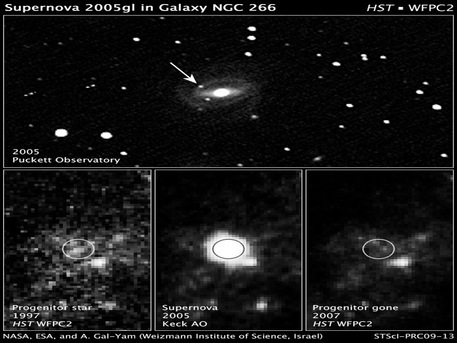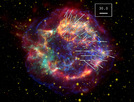Star explosion: One Million years too early
Premature supernova explosion
 |
These pictures show the celestial real estate at all the different points of time. It was very difficult to make out the progenitor of the supernova.
This might mean that we are fundamentally wrong about the evolution of massive stars, and that theories need revising," says Avishay Gal-Yam of the Weizmann Institute of Science, Rehovot, Israel. The supernova explosion showed on October 5, 2005 in the spiral galaxy NBC 266. Pictures from Hubble's achieves from 1997 helped Gal-Yam and his colleague Douglas Leonard from the San Diego State University to identify the progenitor of the supernova. To the surprise of the scientists it was an extremley bright star with 50 to 100 times the mass of the sun.
Those stars are supposed to lose a big chunk of their outer layers due to a strong star wind, which blows it into space. Only after that a center of iron is forming, the nuclear fusion stops and the star explodes in a supernova.
"The progenitor identification shows that, at least in some cases, massive stars explode before losing most of their hydrogen envelope, suggesting that the evolution of the core and the evolution of the envelope are less coupled than previously thought, a finding which may require a revision of stellar evolution theory," says co-author Douglas Leonard from San Diego State University, Calif.
One possibility is that the progenitor to SN 2005gl was really a pair of stars, a binary system that merged. This would have stoked nuclear reactions to brighten the star enormously, making it look more luminous and less evolved than it really is. "This also leaves open the question that there may be other mechanisms for triggering supernova explosions," says Gal-Yam. "We may be missing something very basic in understanding how a superluminous star goes through mass loss."
Dr. Rainer Kayser is a journalist in Hamburg. Translation: Raphael Steinbach
Star explosion: One Million years too early
Premature supernova explosion
 |
These pictures show the celestial real estate at all the different points of time. It was very difficult to make out the progenitor of the supernova.
This might mean that we are fundamentally wrong about the evolution of massive stars, and that theories need revising," says Avishay Gal-Yam of the Weizmann Institute of Science, Rehovot, Israel. The supernova explosion showed on October 5, 2005 in the spiral galaxy NBC 266. Pictures from Hubble's achieves from 1997 helped Gal-Yam and his colleague Douglas Leonard from the San Diego State University to identify the progenitor of the supernova. To the surprise of the scientists it was an extremley bright star with 50 to 100 times the mass of the sun.
Those stars are supposed to lose a big chunk of their outer layers due to a strong star wind, which blows it into space. Only after that a center of iron is forming, the nuclear fusion stops and the star explodes in a supernova.
"The progenitor identification shows that, at least in some cases, massive stars explode before losing most of their hydrogen envelope, suggesting that the evolution of the core and the evolution of the envelope are less coupled than previously thought, a finding which may require a revision of stellar evolution theory," says co-author Douglas Leonard from San Diego State University, Calif.
One possibility is that the progenitor to SN 2005gl was really a pair of stars, a binary system that merged. This would have stoked nuclear reactions to brighten the star enormously, making it look more luminous and less evolved than it really is. "This also leaves open the question that there may be other mechanisms for triggering supernova explosions," says Gal-Yam. "We may be missing something very basic in understanding how a superluminous star goes through mass loss."
Dr. Rainer Kayser is a journalist in Hamburg. Translation: Raphael Steinbach






